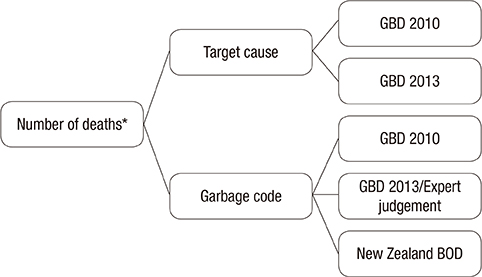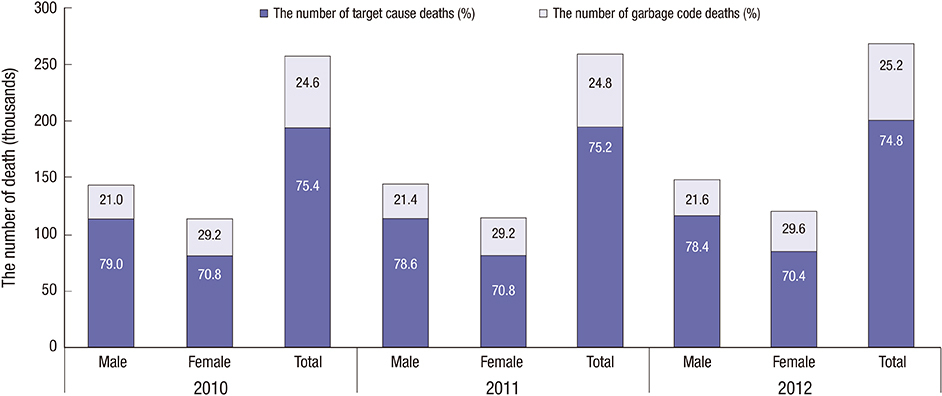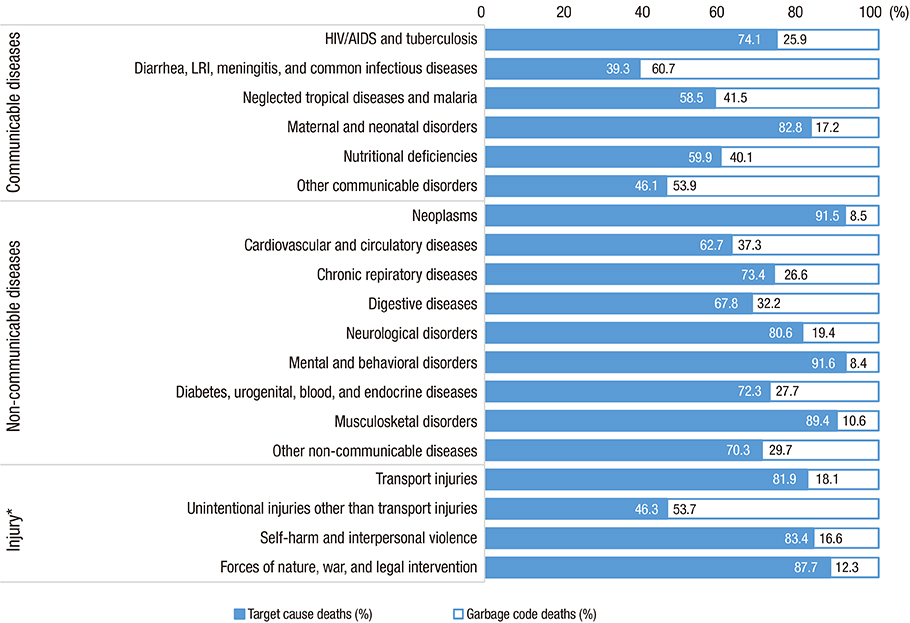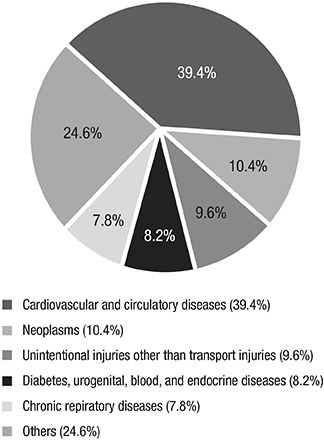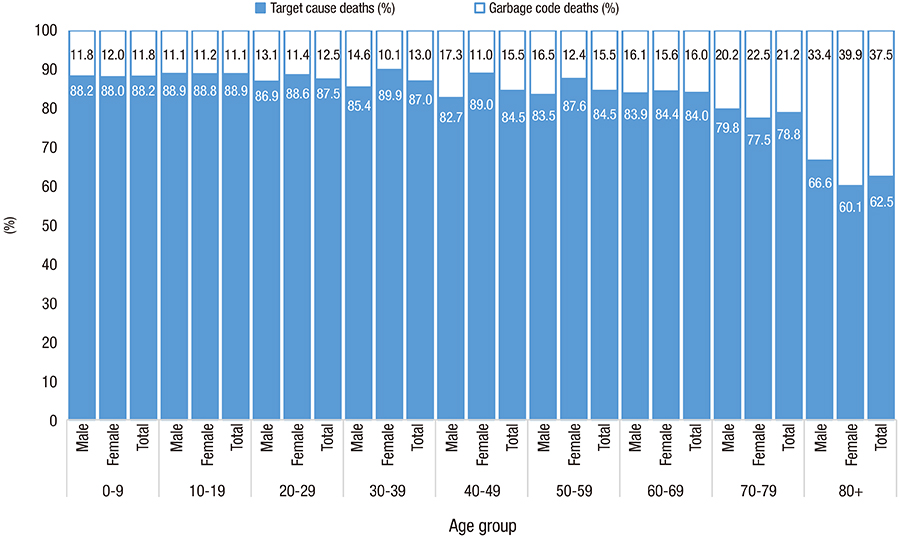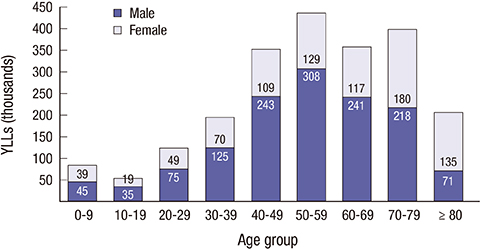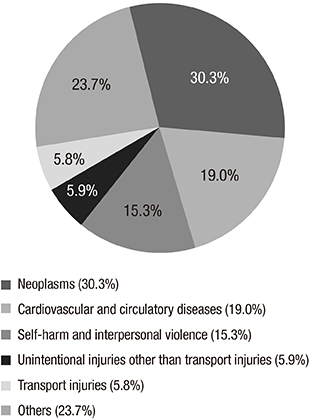Application of a Modified Garbage Code Algorithm to Estimate Cause-Specific Mortality and Years of Life Lost in Korea
- Affiliations
-
- 1Department of Preventive Medicine, School of Medicine, Kyung Hee University, Seoul, Korea. parenchyme@gmail.com
- 2Cancer Policy Branch, National Cancer Control Institute, National Cancer Center, Goyang, Korea.
- 3Department of Medical Education and Humanities, School of Medicine, Kyung Hee University, Seoul, Korea.
- 4Cancer Registration and Statistic Branch, National Cancer Control Institute, National Cancer Center, Goyang, Korea.
- KMID: 2360662
- DOI: http://doi.org/10.3346/jkms.2016.31.S2.S121
Abstract
- Years of life lost (YLLs) are estimated based on mortality and cause of death (CoD); therefore, it is necessary to accurately calculate CoD to estimate the burden of disease. The garbage code algorithm was developed by the Global Burden of Disease (GBD) Study to redistribute inaccurate CoD and enhance the validity of CoD estimation. This study aimed to estimate cause-specific mortality rates and YLLs in Korea by applying a modified garbage code algorithm. CoD data for 2010-2012 were used to calculate the number of deaths. The garbage code algorithm was then applied to calculate target cause (i.e., valid CoD) and adjusted CoD using the garbage code redistribution. The results showed that garbage code deaths accounted for approximately 25% of all CoD during 2010-2012. In 2012, lung cancer contributed the most to cause-specific death according to the Statistics Korea. However, when CoD was adjusted using the garbage code redistribution, ischemic heart disease was the most common CoD. Furthermore, before garbage code redistribution, self-harm contributed the most YLLs followed by lung cancer and liver cancer; however, after application of the garbage code redistribution, though self-harm was the most common leading cause of YLL, it is followed by ischemic heart disease and lung cancer. Our results showed that garbage code deaths accounted for a substantial amount of mortality and YLLs. The results may enhance our knowledge of burden of disease and help prioritize intervention settings by changing the relative importance of burden of disease.
Keyword
Figure
Cited by 9 articles
-
Comparative Research for the Healthcare Budget and Burden of Disease in Perspective Resource Allocation
So-Youn Park, Seok-Jun Yoon, Hyesook Park, Min-Woo Jo, In-Hwan Oh
J Korean Med Sci. 2019;34(Suppl 1):. doi: 10.3346/jkms.2019.34.e81.The Korean National Burden of Disease Study: from Evidence to Policy
Seok-Jun Yoon, Dun-Sol Go, Hyesook Park, Min-Woo Jo, In-Hwan Oh, Young-Eun Kim
J Korean Med Sci. 2019;34(Suppl 1):. doi: 10.3346/jkms.2019.34.e89.Regional Differences in Years of Life Lost in Korea from 1997 to 2015
Dun-Sol Go, Young-Eun Kim, Munkhzul Radnaabaatar, Yunsun Jung, Jaehun Jung, Seok-Jun Yoon
J Korean Med Sci. 2019;34(Suppl 1):. doi: 10.3346/jkms.2019.34.e91.Years of Life Lost due to Premature Death in People with Disabilities in Korea: the Korean National Burden of Disease Study Framework
Young-Eun Kim, Ye-Rin Lee, Seok-Jun Yoon, Young-Ae Kim, In-Hwan Oh
J Korean Med Sci. 2019;34(2):. doi: 10.3346/jkms.2019.34.e22.Trends and Patterns of Burden of Disease and Injuries in Korea Using Disability-Adjusted Life Years
Young-Eun Kim, Hyesook Park, Min-Woo Jo, In-Hwan Oh, Dun-Sol Go, Jaehun Jung, Seok-Jun Yoon
J Korean Med Sci. 2019;34(Suppl 1):. doi: 10.3346/jkms.2019.34.e75.Measuring the Economic Burden of Disease and Injury in Korea, 2015
Ye-Rin Lee, Bogeum Cho, Min-Woo Jo, Minsu Ock, Donghoon Lee, Doungkyu Lee, Moon Jung Kim, In-Hwan Oh
J Korean Med Sci. 2019;34(Suppl 1):. doi: 10.3346/jkms.2019.34.e80.Letter to the Editor: Chronic Kidney Disease - a Neglected Disease in the Economic Conditions Burden Analysis in Korea
Boris Bikbov,
J Korean Med Sci. 2019;34(32):. doi: 10.3346/jkms.2019.34.e220.Disease-Specific Mortality and Prevalence Trends in Korea, 2002–2015
Yoonhee Shin, Bomi Park, Hye Ah Lee, Bohyun Park, Hyejin Han, Eun Jeong Choi, Nam-eun Kim, Hyesook Park
J Korean Med Sci. 2020;35(4):. doi: 10.3346/jkms.2020.35.e27.Trends and Patterns of Cancer Burdens by Region and Income Level in Korea: A National Representative Big Data Analysis
Yoon-Sun Jung, Seok-Jun Yoon
Cancer Res Treat. 2023;55(2):408-418. doi: 10.4143/crt.2022.126.
Reference
-
1. Jung YH. Measuring years of life lost due to premature death in Korea: toward estimating the burden of diseases. Health Welf Policy Forum. 2011; 11:66–74.2. Oh IH, Yoon SJ, Kim EJ. The burden of disease in Korea. J Korean Med Assoc. 2011; 54:646–652.3. Murray CJ, Vos T, Lozano R, Naghavi M, Flaxman AD, Michaud C, Ezzati M, Shibuya K, Salomon JA, Abdalla S, et al. Disability-adjusted life years (DALYs) for 291 diseases and injuries in 21 regions, 1990-2010: a systematic analysis for the global burden of disease study 2010. Lancet. 2012; 380:2197–2223.4. Statistics Korea [Internet]. accessed on 1 September 2015. Available at http://kostat.go.kr/portal/korea/index.action.5. Statistics Korea. e-national index [Internet]. accessed on 11 September 2015. Available at http://www.index.go.kr/potal/main/PotalMain.do.6. Yoon SJ, Oh IH, Seo HY, Kim EJ. Measuring the burden of disease due to climate change and developing a forecast model in South Korea. Public Health. 2014; 128:725–733.7. The Korean Society for Preventive Medicine. Preventive Medicine and Public Health. 2nd ed. Seoul: Gyechukmunhwasa;2013.8. Lozano R, Naghavi M, Foreman K, Lim S, Shibuya K, Aboyans V, Abraham J, Adair T, Aggarwal R, Ahn SY, et al. Global and regional mortality from 235 causes of death for 20 age groups in 1990 and 2010: a systematic analysis for the global burden of disease study 2010. Lancet. 2012; 380:2095–2128.9. Ministry of Health (NZ). Ways and means: a report of methodology from the New Zealand burden of diseases, injuries and risk factor study, 2006-2016 [Internet]. accessed on 8 July 2015. Available at http://www.health.govt.nz/publication/ways-and-means-report-methodology-new-zealand-burden-disease-injury-and-risk-study-2006-2016.10. Chang H, Myoung JI, Shin Y. Burden of disease in Korea: years of life lost due to premature deaths. Korean J Prev Med. 2001; 34:354–362.11. Yoon SJ, Jo MW, Park HS, Oh IH, Kim BS, Kim DW, Yoon JH, Ko SK, Kong YH, Jung JH, et al. A Study on Measuring and Forecasting the Burden of Disease in Korea. Cheongju: Ministry of Health and Welfare;2015.12. Murray CJ, Lopez AD. The Global Burden of Disease: a Comprehensive Assessment of Mortality and Disability from Diseases, Injuries and Risk Factors in 1990 and Projected to 2020 (Global Burden of Disease and Injury Series Vol. 1). Cambridge, MA: Harvard University Press;1996.13. Naghavi M, Makela S, Foreman K, O'Brien J, Pourmalek F, Lozano R. Algorithms for enhancing public health utility of national causes-of-death data. Popul Health Metr. 2010; 8:9–22.14. World Health Organization. WHO methods and data sources for country-level causes of death 2000-2012 [Internet]. accessed on 5 October 2015. Available at http://www.who.int/healthinfo/global_burden_disease/GlobalCOD_method_2000_2012.pdf.15. Hotez PJ, Dumonteil E, Woc-Colburn L, Serpa JA, Bezek S, Edwards MS, Hallmark CJ, Musselwhite LW, Flink BJ, Bottazzi ME. Chagas disease: “the new HIV/AIDS of the Americas. PLoS Negl Trop Dis. 2012; 6:e1498.16. GBD 2013 Mortality and Causes of Death Collaborators. Global, regional and national age-sex specific all-cause and cause-specific mortality for 240 cause of death, 1990-2013: a systematic analysis for the global burden of disease study 2013. Lancet. 2015; 385:117–171.17. Statistics Korea. Korean standard statistical classification [Internet]. accessed on 11 September 2015. Available at http://kssc.kostat.go.kr.18. Jung YH. Avoidable mortality in Korea. Health Welf Policy Forum. 2014; 8:42–53.19. Murray CJ, Richards MA, Newton JN, Fenton KA, Anderson HR, Atkinson C, Bennett D, Bernabé E, Blencowe H, Bourne R, et al. UK health performance: findings of the global burden of disease study 2010. Lancet. 2013; 381:997–1020.20. Bradshaw D, Pillay-Van Wyk V, Laubscher R, Nojilana B, Groenewald P, Nannan N, Metcalf C. Cause of Death Statistics for South Africa: Challenges and Possibilities for Improvement. Cape Town: South African Medical Research Council;2010.
- Full Text Links
- Actions
-
Cited
- CITED
-
- Close
- Share
- Similar articles
-
- Disability-Adjusted Life Years for Communicable Disease in the Korean Burden of Disease Study 2012
- Disability-Adjusted Life Years Analysis: Implications for Stroke Research
- A Study on the Life Eexpectancy and Years of Potential Life Lost of the Person affected Leprosy in Korean
- Premature Deaths Attributable to Long-term Exposure to Ambient Fine Particulate Matter in the Republic of Korea
- Does Living nearby a Garbage Dumping Site Degrade the Quality of Life? A Case Study based on Shin-dong Myeon Residents, Chun-cheon Si

